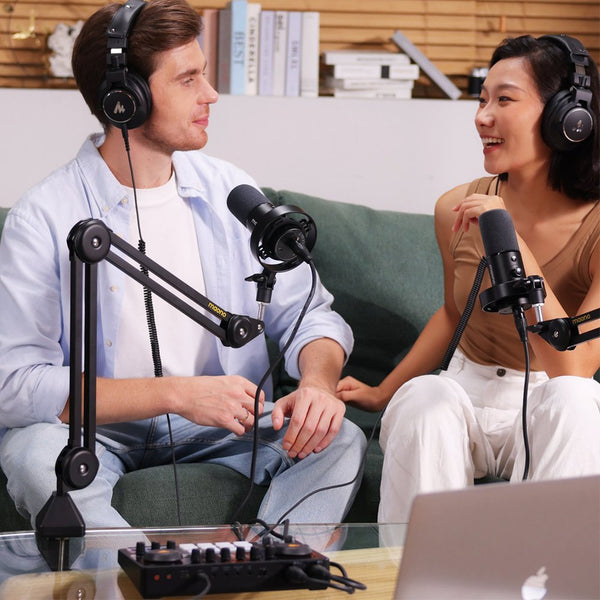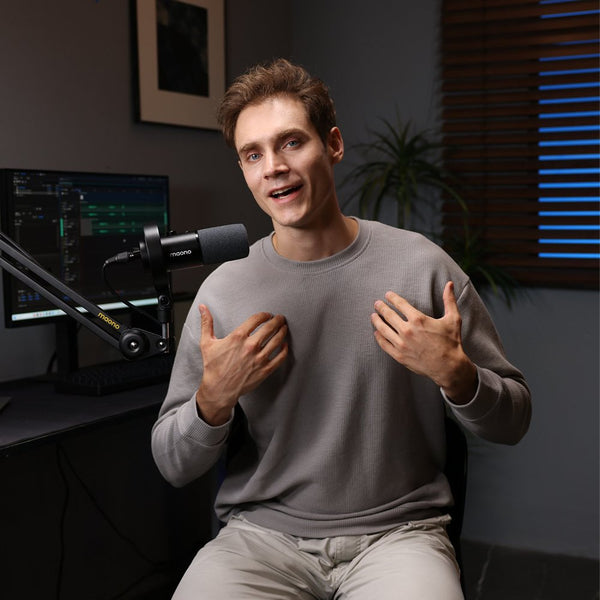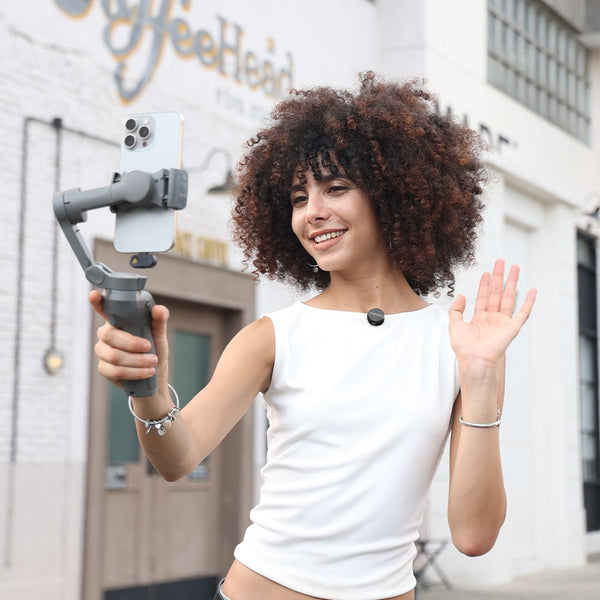You have topics in mind to discuss and want to start a podcast soon, but you’re wondering: 'Can I really start a podcast from my bedroom or home office?' Keep reading.
Whether you want to share your story, teach something valuable, or entertain a niche audience, a home-based podcast is a practical and affordable way to do it—especially with the right podcast microphone.
But how exactly do you get started? What gear do you need? And perhaps one of the most debated topics among beginners: Should you use a USB mic or an XLR mic for your home podcasting microphone setup?
This step-by-step guide answers these questions and more. We’ll walk you through the essentials—from gear recommendations to audio setup and publishing—and offer tips to help your podcast sound professional without leaving your home.

Pros and Cons of Recording a Podcast from a Home Setup
Pros:
-
Affordability
No need to rent a studio or hire expensive engineers. -
Flexibility
Record on your schedule, at your own pace. -
Creative control
You’re in charge of content, editing, and publishing. -
Comfort
You can build your ideal setup without leaving your home.
Cons:
-
Background noise
Home environments are rarely acoustically perfect. -
Learning curve
You’ll need to learn some basic audio editing. -
Technical setup
Troubleshooting issues like echo or mic placement may take time.
Despite the downsides, recording from home is the go-to choice for many beginners and even seasoned podcasters—especially with the right tools and techniques, including a good microphone for podcast use.
Common Questions for Beginning Podcasters:
1. How do I set up my home studio for optimal audio quality?
Start by choosing a quiet space away from windows, appliances, and echo-heavy walls. Use rugs, curtains, and foam panels to absorb reflections. Even placing a mattress against the wall can help!
2. Do I need a soundproof room to record a podcast at home?
Not necessarily. Soundproofing blocks outside noise, while sound treatment improves recording quality. You can get solid results with sound treatment alone, such as carpets, curtains, and foam panels.
3. What is the minimum equipment I need to start podcasting at home?
-
Microphone: A dynamic mic like the Maono PD400X is an excellent starter. It offers both USB and XLR output, giving you flexibility to upgrade later. It’s a strong contender for the best home studio mic in its class.
-
Headphones: Closed-back headphones like the Maono MH601 let you monitor sound without mic bleed.
-
Pop filter or foam windscreen: Helps reduce plosives (like hard “p” and “b” sounds).
-
Mic stand or boom arm: Keeps the mic steady and positioned correctly.
-
Laptop or desktop computer
4. What free recording software is best for beginners podcasting from home?
-
Audacity: Free, open-source, and user-friendly.
-
GarageBand: Great for Mac users with built-in features for podcasting.
-
Ocenaudio: Another beginner-friendly editor with real-time effects.
5. How do I reduce background noise when recording at home?
Turn off fans and AC units during recording. Record in the quietest room possible and use a mic with a cardioid polar pattern (like the Maono PD400X) that focuses on your voice and minimizes ambient noise. Use noise reduction plugins in post-production if necessary.
6. Should I record into a digital audio workstation (DAW) or use a podcast mixer?
Beginners can start with a DAW like Audacity. If you're co-hosting or planning live shows, consider a podcast mixer like the Maonocaster AME2 to manage multiple inputs and add sound effects.
7. How can I get a consistent sound if I don't have professional acoustic panels?
-
Record in the same space each time.
-
Maintain a fixed mic distance (about 6–8 inches).
-
Use EQ and compression presets to normalize your sound.
8. What’s the best mic placement for home podcast recording?
Position your mic slightly off-center (not directly in front of your mouth) and about 6 inches away. Use a pop filter and ensure the mic is angled toward your mouth. Proper podcasting microphone setup can make a noticeable difference in clarity and tone.
9. Can I publish a podcast from home without hiring an editor?
Absolutely. Many beginners self-edit using tools like Audacity or paid services like Descript or Alitu, which simplify the editing process with user-friendly interfaces.
10. Do I need a website for my home-based podcast?
A website helps you establish authority, provide show notes, and grow an email list. While not required, it’s highly recommended as your podcast grows.
11. How do I submit my podcast to Spotify, Apple Podcasts, and Google Podcasts?
First, sign up with a podcast hosting platform like Buzzsprout, Podbean, or Anchor. These services generate your RSS feed, which you can submit to major directories with a few clicks.
12. How often should I release episodes when podcasting from home?
Consistency is key. Choose a schedule (weekly, biweekly, monthly) you can realistically maintain. Many new podcasters start with a weekly cadence to build momentum.
Tips to Improve Home Studio Podcast Sound
1. When is the right time to upgrade from USB to XLR in a home studio?
When you’re ready to improve audio fidelity, handle multiple microphones, or fine-tune sound via an audio interface or mixer. The Maono PD400X supports both USB and XLR, making it perfect for upgrading without changing mics. It's both a studio mic and a long-term solution.
2. How can I interview guests remotely from my home podcast studio?
Use tools like Zoom, Riverside.fm, or Zencastr for remote interviews. For the best results, ask your guest to wear headphones and use an external mic if possible.
3. What are affordable soundproofing solutions for podcasters?
-
Foam panels (12-packs on Amazon are budget-friendly)
-
Heavy curtains or moving blankets
-
DIY vocal booth using a box lined with foam
-
Record in closets or small carpeted rooms
4. Can I monetize my podcast if I’m recording from home?
Yes! Once you build an audience, you can earn through sponsorships, listener donations (e.g., Patreon), affiliate marketing, or selling your own products and services.
5. How do I make my podcast sound professional without a full studio budget?
-
Invest in a good microphone for podcast recording like the Maono PD400X
-
Learn basic editing skills
-
Record in a treated room
-
Maintain consistent audio levels
-
Use intro/outro music for branding
-
Stick to a format or show structure that works for your audience
Conclusion
Launching a podcast from your home is not only possible—it’s more popular than ever. With a small investment in quality gear like a versatile podcasting microphone, a basic home setup, and free software, you can create a podcast that sounds polished and professional. By addressing common technical concerns, treating your room for better audio, and staying consistent with your publishing schedule, you can grow your podcast audience right from your living room.
Whether you’re sharing expertise, telling stories, or starting a side project, your voice deserves to be heard. Don’t wait for the perfect studio mic—start recording today, and let your podcast journey begin from home.



